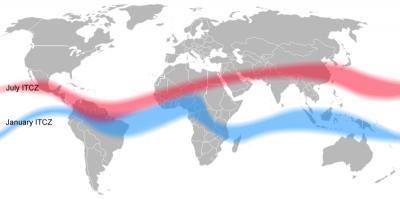An estimate finds that a northward shift of Earth's wind and rain belts could make a broad swath of regions drier, including the Middle East, American West and Amazonia, while making Monsoon Asia and equatorial Africa wetter.
The authors based their prediction on knowledge of warming that brought Earth out of the last ice age about 15,000 years ago and climate data collected from around the world, from tree-rings, polar ice cores, cave formations, and lake and ocean sediments. Based on that, they hypothesize that the wind and rain belts shifted north from about 14,600 years ago to 12,700 years ago as the northern hemisphere was heating up.
As the North Atlantic Ocean began to churn more vigorously, it melted Arctic sea ice, setting up a temperature contrast with the southern hemisphere where sea ice was expanding around Antarctica. The temperature gradient between the poles appears to have pushed the tropical rain belt and mid-latitude jet stream north, redistributing water in two bands around the planet. If Arctic sea ice continues to retreat, and with the northern hemisphere heating up faster than the south, history could repeat itself, they believe.

During boreal summer, Earth's tropical rain belt migrates north. A similar but prolonged shift could happen if the north continues to heat faster than the south, disrupting global rainfall patterns. Credit: Mats Halldin
At the southern edge of the tropical rain belt, the great ancient Lake Tauca in the Bolivian Andes nearly dried up at this time while rivers in eastern Brazil slowed to a trickle and rain-fed stalagmites in the same region stopped growing. In the middle latitudes, the northward advance of the jet stream may have caused Lake Lisan, a precursor to the Dead Sea in Jordan's Rift Valley, to shrink, along with several prehistoric lakes in the western U.S., including Lake Bonneville in present day Utah.
Meanwhile, a northward shift of the tropical rains recharged the rivers that drain Venezuela's Cariaco Basin and East Africa's Lake Victoria and Lake Tanganyika. Stalagmites in China's Hulu Cave grew bigger. Evidence for a stronger Asian monsoon during this time also shows up in the Greenland ice cores.
The process worked in reverse from about 1300 to 1850, the study authors hypothesize, as northern Europe transitioned from the relatively warm medieval era to a colder period known as the Little Ice Age. Ocean circulation slowed, and sea ice in the North Atlantic Ocean expanded, the climate record shows. At the same time, rainfall declined in Monsoon Asia, leading to a series of droughts that have been linked to the decline of Cambodia's ancient Khmer civilization, China's Ming dynasty and the collapse of kingdoms in present day Vietnam, Myanmar and Thailand.
In the southern hemisphere, the reconstruction of glacier extents in New Zealand's Southern Alps suggests that the mid-latitudes may have been colder during medieval times, supporting the idea of a temperature contrast between the hemispheres that altered rain and wind patterns.
A similar migration of Earth's wind and rain belts happens each year. During boreal summer, the tropical rain belt and mid-latitude jet stream migrate north as the northern hemisphere heats up disproportionately to the south, with more continents to absorb the sun's energy. As the northern hemisphere cools off in winter, the winds and rains revert south.
Sometimes the winds and rains have rearranged themselves for longer periods of time. In the 1970s and 1980s, a southward shift of the tropical rain belt, attributed to air pollution cooling the northern hemisphere, is thought to have brought devastating drought to Africa's Sahel region. The tropical rain belt has since reverted back, and may be moving north, the study authors say, as suggested by a number of recent droughts, including in Syria, northern China, western U.S., and northeastern Brazil.
"If the kinds of changes we saw during the deglaciation were to occur today that would have a very big impact," said the study's lead author, Wallace Broecker, a climate scientist at Columbia University's Lamont-Doherty Earth Observatory, about their upcoming paper in PNAS.
Consistent with the study, at least one climate model shows the tropical rain belt moving north as carbon dioxide levels climb and temperatures warm. "It's really important to look at the paleo record," said Dargan Frierson, an atmospheric scientist at University of Washington whose modeling work supports the authors' hypothesis. "Those changes were huge, just like we're expecting with global warming."
The study authors acknowledge that their hypothesis has some holes. In the past, changes in sea ice cover drove the temperature gradient between the two hemispheres while today rapidly rising industrial carbon emissions are responsible. So far, there is also no clear evidence that ocean circulation is increasing in the North Atlantic or that the monsoon rains over Asia are strengthening (though there is speculation that sulfate aerosols produced by burning fossil fuels may be masking this effect).
As air pollution in the northern hemisphere declines, temperatures may warm, creating the kind of temperature contrast that could move the winds and rains north again, said Jeff Severinghaus, a climate scientist at Scripps Institution of Oceanography who was not involved in the study.
"Sulfate aerosols will probably get cleaned up in the next few decades because of their effects on acid rain and health," he said. "So Broecker and Putnam are probably on solid ground in predicting that northern warming will eventually greatly exceed southern warming."




Comments